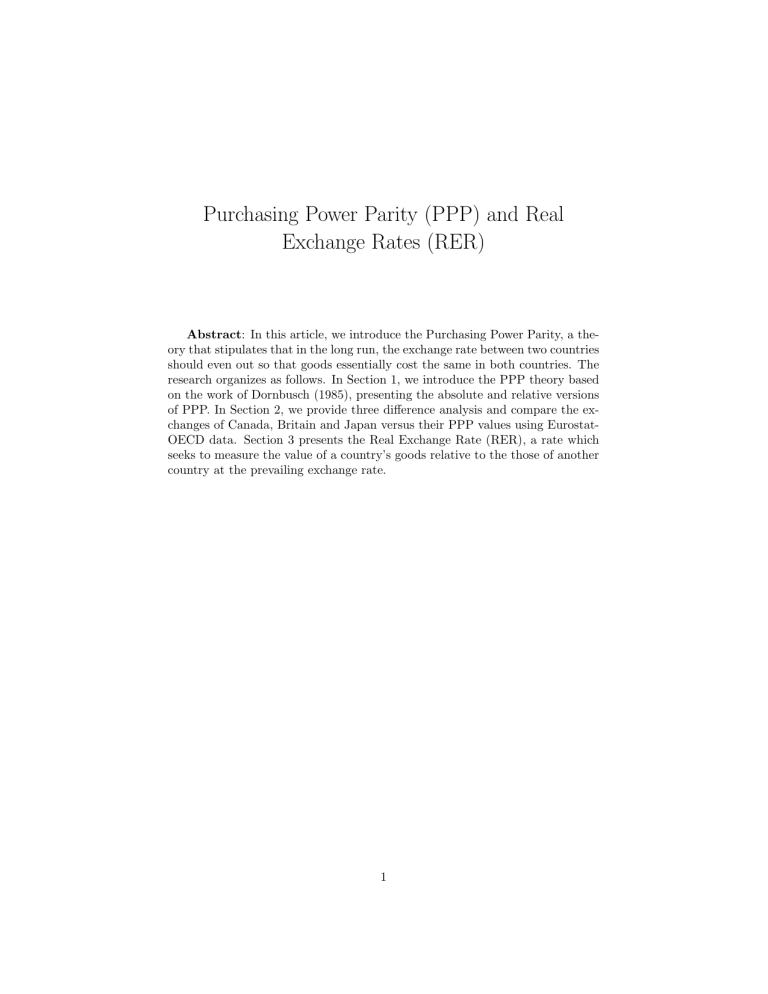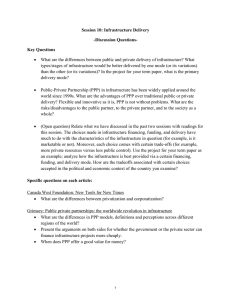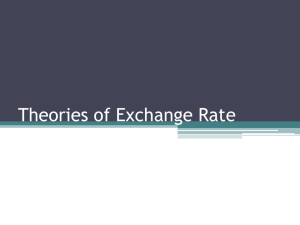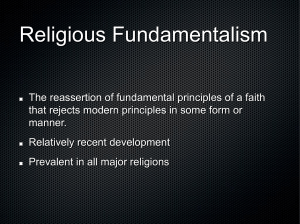
Purchasing Power Parity (PPP) and Real Exchange Rates (RER) Abstract: In this article, we introduce the Purchasing Power Parity, a theory that stipulates that in the long run, the exchange rate between two countries should even out so that goods essentially cost the same in both countries. The research organizes as follows. In Section 1, we introduce the PPP theory based on the work of Dornbusch (1985), presenting the absolute and relative versions of PPP. In Section 2, we provide three difference analysis and compare the exchanges of Canada, Britain and Japan versus their PPP values using EurostatOECD data. Section 3 presents the Real Exchange Rate (RER), a rate which seeks to measure the value of a country’s goods relative to the those of another country at the prevailing exchange rate. 1 1 Purchasing Power Parity: A quick introduction In this Section, We can start by introducing Rudiger Dornbusch’s NBER Paper on PPP published in March 1985. In his working paper, Professor Dornbusch states that the PPP theory of exchange rate has ‘the same status in the history of economic thought and in economic policy as the Quantity Theory of Money (QT)’. The QT version most commonly used is the Fisher Identity (Economist Irving Fisher in his book The Purchasing Power of Money) defined by: M.V = P.T (1) where, • M: Money supply, or stock of money in coins, notes and bank deposits • V: Velocity of circulation • P: Some measure of the Price level (i.e. CPI) • T: Volume of Transactions in the economy 1.1 Historical Context The notion of purchasing power parity PPP can be traced to the 16-century Spanish Salamanca school, but the protagonist of the theory is the Swedish Economist Gustav Cassel. During and after WWI, he observed that countries like Germany or Hungary experienced a sharp depreciation of the purchasing power of their currencies in addition to hyperinflation. Therefore, he proposed a model of PPP that became a benchmark for long run nominal exchange rate determination. 1.2 Historical Context Let Pi and Pi∗ be the price of the ith commodity at home and abroad respectively (both in local currencies) and e the bilateral exchange rate. Let P and P ∗ represent the price level at home and abroad. In an integrated, competitive market (no cost for transport and no barriers to international trade for the good), the concept is based on the Law of one Price where identical goods will have the same price in different markers when quoted in the same currency. For unless: Pi = e.Pi∗ there will an opportunity of profitable arbitrage. 2 (2) Arbitrage: Recall that arbitrage is the possibility to make a profit in financial market without risk and without net investment of capital. A portfolio Π has an arbitrage opportunity if there exists t > 0, such that: X0 = 0, Xt ≥ 0(P − a.s.), P (Xt > 0) > 0. For instance, if Pi < e.Pi∗ , then an arbitrageur will buy the good domestically for Pi , sell it abroad for Pi ∗ and realize a risk-free profit as Pi ∗ .e − Pi > 0. Such arbitrage, purchasing the cheap good and selling it where it is dear, would continue until the equality (2) holds. As we said, equation (2) states that the price of the ith commodity must be the same in both markets (i.e. two different countries, for instance US and UK). The Equation is known as Commodity Price Parity (CPP). Example: Let’s say that the price of one ounce of gold sold in London is 846 GBP, whereas it is sold of for USD 1,290 in New York. If we apply equation (2), we can conclude that the implied rate for Cable (GBP/USD) is 1.5248 (as a result of 1,290 / 846). Limits: reasons: As we all know, in the real world, CPP may not hold for different • Transactions costs (transportations costs, insurance fees) • Non-traded Goods: items such as electricity, water supply, or goods with very high transportation costs such as gravel • Restraints of Trade • Imperfect Competition 1.3 Purchasing Power In an economy with a collection of commodities, ‘purchasing power’ is defined in terms of a representative bundle of goods. We evaluate purchasing power by constructing a price index based on a basket of (consumption) goods. There are two forms of Purchasing Power Parity, Absolute and Relative PPP 1.3.1 Absolute Purchasing Power Parity Let P = f (p1 , . . . , pi , . . . , pn ) and P ∗ = g(p∗1 , . . . , p∗i , . . . p∗n ) be domestic and foreign price indices. 3 Then, if the prices of each good (in dollars) are equalized across countries, and if the same goods enter each country’s market basket with the same weights, then Absolute PPP prevails: P e= ∗ =k (3) P if pp∗i = k for i = 1, ..., n. i There can be no objection to equation (2) as a theoretical statement. However, as we mentioned it earlier (limits), objections arise when equation (2) is interpreted as an empirical proposition (Tariffs, transportation costs make it difficult for the spot prices of a commodity i to be equal in different location at a given time). Strong (Absolute) PPP implies that whatever monetary or real disturbances in the economy, the price of a common market of basket of goods will be the same, i.e.: P =1 (4) e.P ∗ 1.3.2 Relative Purchasing Power Parity The relative version of PPP restates the theory in terms of changes in relative price levels and exchange rate: e= C.P P∗ (5) where C is a constant that reflect the trade obstacles. The difference in the rate of change in prices at home and abroad – difference in the inflation rate – is equal to the percentage depreciation or appreciation of the exchange rate: ∆e = Π − Π∗ (6) where ∆ denotes the change (percentage as e is logged), Π − Π∗ the inflation differences between two markets (i.e. countries) reflected in percentage changes in the exchange rate. For instance, if the inflation rate is Π = 2% in the US and Π∗ = 1% in the UK, then the British Pound (GBP) should appreciate by ∆e = Π − Π∗ = 1% against the USD. Prices in the US are rising faster than in the UK, therefore UK exports are becoming more competitive (compare to US ones), raising importers’ interest. This should generate a higher demand for GBP (relative to USD), hence sending Cable (GBP/USD) higher. 4 2 Eurostat-OECD PPP In this section, we are going to use the Eurostat and OECD PPP data to provide three different analysis of FX spot rates (GBP, JPY and CAD) against their PPP values since the collapse of the Bretton Woods system in 1971. The computation is described in their manual called Eurostat-OECD Methodologies Manual on Purchasing Power Parities. 2.1 USD/GBP analysis In the early 1970s, Cable was way undervalued compare to its PPP value, which converged slowly to the FX spot rate around 2.10 in 1979. Then, for the next three and half decades, we can say that the Exchange Rate has oscillated around its fundamental PPP value (Figure 1). The only big divergence we saw was in the 1980s as a consequence of the Federal Reserve increasing its interest rate up to 18% to fight inflation coming from the second oil shock (Shah Revolution in Iran). This sudden tightening cycle gave birth to the Dollar Reagan Rally between 1980 and 1985, which could explain the reason why Cable diverged sharply from its fundamental value. This rally was halted after the Plaza Agreements in September 1985 (in which the major central banks pledged to work towards a weaker US Dollar and a reduction of US Current Account Deficit) and the FX spot rate converged back toward its PPP level. Since 1990, the spot rate has more or less traded around its fundamental value. The recent drop that pushed Cable below its fair value are the consequences of Brexit as the pound was clearly hurt from investments outflows (i.e. property funds) and new easing measures announced by the Bank of England (25bps rate cut in addition to 60bn GBP QE expansion within the next 18 months). We could see more divergence [from the fundamental value] as the UK is clearly on its way to reach a ZIRP policy in the near future, which would add pressure to the British pound. 5 Figure 1: USD/GBP spot rate (red line) versus PPP (black line) 2.2 JPY/USD analysis In 1970, the fundamental value (PPP, black line) was estimated at around 225 while the FX spot rate was fixed at 360 JPY per USD. The Japanese currency was fairly undervalued (against the USD) for a long time according to economists, which could explain the large current account surpluses mainly driven by exports due to a cheap currency (click here for more details about The History of the Japanese Yen). After Bretton Woods ended, the Yen experienced two decades of appreciation against the greenback and constantly traded below its fundamental value between 1985 and 2013. Then, the new measures launch by the trio Abe/Kuroda/Aso in 2012-2013 led to a massive Yen weakening period and the exchange rate eventually crossed over its fair value [according to Eurostat-OECD PPP] in 2014. The results of Abenomics levitated JPY/USD from the mid-70s level in Q3 2012 to a high of 125 in June 2015, while the PPP index remained quite steady at around 105. However, the weak global macro environment (lower global growth, Brexit and the European Banks, Fed delaying its tightening cycle. . . ) in addition to no further BoJ stimulus (more details here) has played in favor of the Yen over the past year; USDJPY declined sharply below its fundamental value and is currently flirting with the psychological 100 support. The real question now is how far will the Japanese Government [and the BoJ] let the currency pair diverge from its fundamental value on the downside before intervening in the market? 6 Figure 2: JPY/USD spot rate (red line) versus PPP (black line) 2.3 CAD/USD analysis For our last PPP analysis, we chose a commodity currency: the Canadian Dollar also called the Loonie (Figure 3). It is pretty clear that all of the three charts show us that over a long period of time, the FX spot rate tend to mean-revert towards its ’fair ’ value if it diverges too far away from it. I think that it is interesting to look at how commodity currency exchange rates (i.e. the Loonie) react vis-à-vis their fair PPP value. As opposed to the British pound (Figure 1), we can see that CAD/USD FX spot rate is much more volatile [relative to its PPP value], and therefore CAD/USD tends to divergence much more from its fundamental value and for a longer period of time. For instance, we first had an important divergence during the Reagan Rally where CAD/USD rose from 1.15 to 1.40 (which means strong Canadian Dollar depreciation against the USD), but more importantly during the 1990s Clinton Rally when the Fed started a tightening cycle. The divergence is also explained by the sharp decline of the Canadian Dollar in the 1990s. The 90-91 recession that followed a significant interest rate increase, fiscal and political uncertainty during the mid-1990s in addition to the Quebec referendum of 1995 led to a progressive weakening of the Loonie (M. Devereux, 2008). On the top of that, the Asian financial crisis in 1997 led to a fall in commodity prices, which obviously accelerated the Canadian Dollar meltdown. CAD/USD reached an annual average high of 1.5700 in 2002 [according to OECD data] and the market was speculating on a Fall of the Loonie. The situation reversed then and between 2002 and 2011, we saw a dramatic appreciation of the Loonie. It looks to me that the more a currency diverges 7 from its fundamental value, the sharper the reversal is. This long period of Loonie strength could be summarize by the Super-Commodity cycle led by the elevated growth coming from Emerging Markets (the famous BRICs). We can observe another important reversal in 2012, which has mainly been explained by the end of the super-cycle. Since 2012, commodity currencies (i.e. AUD, NZD, CAD or ZAR) suffered dramatic losses due to a decreasing global demand (slowing growth coming from China, the fall of Russia then Brazil, Fragile Fives. . . ) which impacted the commodity market. The Loonie is once again undervalued according to the PPP Fair Value and the situation is not going to get better anytime soon in our opinion. Therefore, we could see further divergence from the fair value in the medium term (12-18 months) and LT mean reversal shorts should wait for the exchange rate [CAD/USD] to reach higher levels. Figure 3: CAD/USD spot rate (red line) versus PPP (black line) 3 Real Exchange Rates (RER) The real exchange rate (RER) seeks to measure the value of a country’s goods relative to those of another country at the prevailing nominal exchange rate. It is defined by the following formula: Qt = St ∗ 8 Pt ∗ Pt (7) where Pt ∗ represents the price of foreign goods, Pt represents the price of domestic goods and St the nominal exchange rate (capital letters mean not logged). If [absolute] PPP holds, therefore the real exchange rate Qt = 1 as the price of goods would cost the same in the domestic country (i.e. United States) as in the foreign country (Great Britain) when the price is expressed in a common currency. However, we saw in our three cases that PPP doesn’t hold as FX spot rates tend to be usually overvalued or undervalued compare to their fundamental value. From the formula above, we know that the competitiveness of the foreign country improves when Qt < 1 as the foreign currency is undervalued according to the PPP model that we used. On the contrary, if Qt > 1 , the foreign currency is overvalued and the competitiveness of the foreign country deteriorates. In our examples, we have the following results: 1. GBPUSD: Qt = 1.325 1.40 = 0.9464 < 1, which means that British Pound is undervalued vis-à-vis the US Dollar. 2. USDJPY: Qt = (1/100)/(1/104) = 104 100 = 1.04 > 1, the Japanese Yen is currently overvalued against the US Dollar according to PPP. 3. USDCAD: Qt = (1/1.2850)/(1/1.2150) = 1.2150 1.2850 = 0.9420 < 1, i.e. the Canadian Dollar is undervalued against the greenback. Even though the RER indexes between two countries, a more interesting measure would be the Real Effective Exchange Rate (REER) which gives a bilateral RERs average between the domestic country and each of its trading partners, weighted by the trade shares of each business partner. Therefore, our next article will be on how to calculate a REER series for a specific country and see if that country has an undervalued or overvalued exchange rate respective to its trading partners. 4 References Cassel, Gustav. 1918 ”Abnormal deviations in international exchanges”, The Economic Journal, 28, 413-415. Dornbusch, Rudiger. 1985. ”Purchasing Power Parity”. NBER paper, MIT. Fisher, Irving. 1911. ”The Purchasing Power of Money”. New York: The Macmillan Co. 9



